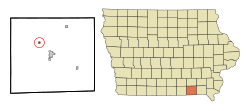Drakesville, Iowa
Drakesville is a city in Davis County, Iowa, United States. The population was 184 at the 2010 census.
Drakesville, Iowa | |
|---|---|
_on_the_Mormon_Pioneer_National_Historic_Trail_(2004)_(ed1f6609-00b3-4353-add9-68ea9c5eeac8).jpg) Drakesville Park | |
 Location of Drakesville, Iowa | |
| Coordinates: 40°47′57″N 92°28′52″W | |
| Country | |
| State | |
| County | Davis |
| Area | |
| • Total | 0.25 sq mi (0.64 km2) |
| • Land | 0.25 sq mi (0.64 km2) |
| • Water | 0.00 sq mi (0.00 km2) |
| Elevation | 883 ft (269 m) |
| Population | |
| • Total | 184 |
| • Estimate (2019)[3] | 190 |
| • Density | 772.36/sq mi (298.12/km2) |
| Time zone | UTC-6 (Central (CST)) |
| • Summer (DST) | UTC-5 (CDT) |
| ZIP code | 52552 |
| Area code(s) | 641 |
| FIPS code | 19-22350 |
| GNIS feature ID | 0456008 |
History
Drakesville (historically Drakeville) was founded in 1847.[4] It was named for its founder, John A. Drake.[5]
Geography
Drakesville is located at 40°47′57″N 92°28′52″W (40.799029, -92.481088).[6]
According to the United States Census Bureau, the city has a total area of 0.25 square miles (0.65 km2), all land.[7]
Demographics
| Year | Pop. | ±% |
|---|---|---|
| 1870 | 207 | — |
| 1880 | 300 | +44.9% |
| 1890 | 303 | +1.0% |
| 1900 | 238 | −21.5% |
| 1910 | 249 | +4.6% |
| 1920 | 261 | +4.8% |
| 1930 | 190 | −27.2% |
| 1940 | 252 | +32.6% |
| 1950 | 222 | −11.9% |
| 1960 | 197 | −11.3% |
| 1970 | 163 | −17.3% |
| 1980 | 212 | +30.1% |
| 1990 | 172 | −18.9% |
| 2000 | 185 | +7.6% |
| 2010 | 184 | −0.5% |
| 1850 | 198 | +7.6% |
| 2019 | 190 | −4.0% |
| Source:"U.S. Census website". United States Census Bureau. Retrieved 2020-03-29. and Iowa Data Center Source: | ||
Drakesville is located in the center of Iowa's fastest growing Amish community http://www.iowaamish.com
2010 census
As of the census[2] of 2010, there were 184 people, 76 households, and 47 families living in the city. The population density was 736.0 inhabitants per square mile (284.2/km2). There were 85 housing units at an average density of 340.0 per square mile (131.3/km2). The racial makeup of the city was 99.5% White and 0.5% from two or more races. Hispanic or Latino of any race were 0.5% of the population.
There were 76 households of which 25.0% had children under the age of 18 living with them, 50.0% were married couples living together, 10.5% had a female householder with no husband present, 1.3% had a male householder with no wife present, and 38.2% were non-families. 27.6% of all households were made up of individuals and 11.8% had someone living alone who was 65 years of age or older. The average household size was 2.42 and the average family size was 3.06.
The median age in the city was 41 years. 25.5% of residents were under the age of 18; 9.8% were between the ages of 18 and 24; 19% were from 25 to 44; 27.2% were from 45 to 64; and 18.5% were 65 years of age or older. The gender makeup of the city was 42.4% male and 57.6% female.
2000 census
At the 2000 census,[9] there were 185 people, 78 households and 46 families living in the city. The population density was 746.4 per square mile (285.7/km2). There were 88 housing units at an average density of 355.0 per square mile (135.9/km2). The racial makeup of the city was 96.22% White, 0.54% African American, and 3.24% from two or more races. Hispanic or Latino of any race were 2.70% of the population.
There were 78 households of which 30.8% had children under the age of 18 living with them, 51.3% were married couples living together, 5.1% had a female householder with no husband present, and 41.0% were non-families. 33.3% of all households were made up of individuals and 19.2% had someone living alone who was 65 years of age or older. The average household size was 2.37 and the average family size was 3.15.
Age distribution was 26.5% under the age of 18, 7.0% from 18 to 24, 28.6% from 25 to 44, 20.0% from 45 to 64, and 17.8% who were 65 years of age or older. The median age was 40 years. For every 100 females, there were 88.8 males. For every 100 females age 18 and over, there were 81.3 males.
The median household income was $26,875, and the median family income was $32,500. Males had a median income of $25,625 versus $23,438 for females. The per capita income for the city was $13,063. About 14.7% of families and 11.6% of the population were below the poverty line, including 2.6% of those under the age of eighteen and 26.9% of those sixty five or over.
References
- "2019 U.S. Gazetteer Files". United States Census Bureau. Retrieved July 17, 2020.
- "U.S. Census website". United States Census Bureau. Retrieved 2012-05-11.
- "Population and Housing Unit Estimates". United States Census Bureau. May 24, 2020. Retrieved May 27, 2020.
- History of Davis County, Iowa. State Historical Company. 1882. pp. 589.
- Gannett, Henry (1905). The Origin of Certain Place Names in the United States. Govt. Print. Off. pp. 109.
- "US Gazetteer files: 2010, 2000, and 1990". United States Census Bureau. 2011-02-12. Retrieved 2011-04-23.
- "US Gazetteer files 2010". United States Census Bureau. Archived from the original on 2012-07-02. Retrieved 2012-05-11.
- "Census of Population and Housing". Census.gov. Retrieved June 4, 2015.
- "U.S. Census website". United States Census Bureau. Retrieved 2008-01-31.